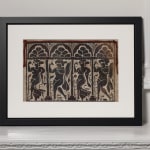Egyptian
An Egyptian 'Coptic' textile fragment, circa 4th - 6th century AD
Wool, linen
Framed size: 53 cm x 40 cm
Preserving in brown-purple wool on a cream linen ground. The rectangular panel with four dancing figures, each within an aedicula surmounted with a palmette. The figures alternate, a nude male...
Preserving in brown-purple wool on a cream linen ground. The rectangular panel with four dancing figures, each within an aedicula surmounted with a palmette. The figures alternate, a nude male figure with a cloak about his shoulders and a shield, with a draped female figure. With a red wool border around the upper section.
Provenance
Swiss private collection acquired in the 1950s
Literature
For a similar tapestry band with dancers within an arcade cf. D. Thompson, Coptic Textiles in the Brooklyn Museum, New York, 1967, p.50-51, no. 20. There is also a more complete example in the Walters Art Museum, Baltimore acc. no. 83.485. Such bands probably formed the upper transverse decoration from a tunic. The cult of Dionysus continued in popularity into early Byzantine times (4th-7th century), and this panel probably depicted dancers involved in a Dionysiac procession. For discussion and exempla see E. Dauterman Maguire, Weavings from Roman, Byzantine and Islamic Egypt, Illinois, 1996, pp. 87-93.Textiles like this one are thought to have been produced by Copts (Christian Egyptians) and other weavers throughout the Byzantine Empire. The designs and motifs of Coptic and Byzantine textiles influenced the visual repertoire of the early Islamic period. For further discussion of Late Antique textiles, see A. Stauffer, Textiles of Late Antiquity, The Metropolitan Museum of Art, 1995.



